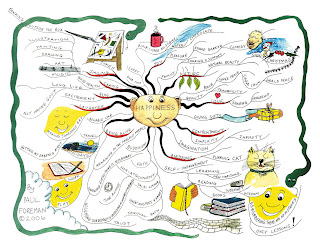I'm sure you are no stranger to this visual thinking tool. A mind map is used for idea generation, visualization and organization, and is great for a structured planning of writing, classifying notes, problem solving and studying, and has been vastly applied throughout our education process for its efficiency. It usually consists of a network of branched out categories with the main topic/theme in the middle. Here are a couple of examples of mind maps:
Tony Buzan, the inventor of mind mapping, claims that the mind map is a vastly superior note taking method because it does not lead to a "semi-hypnotic trance" state induced by other note forms. There are some guidelines to follow in order to create a good mind map:
a) Start in the center with an image of the topic.
b) Use images, symbols, codes, and dimensions throughout your mind map.
c) Keep the topics label as short as possible.
d) Vary text size, color and alignment.
e) Use multiple colors throughout the mind map, for visual stimulation and also to encode or group.
f) Use emphasis and show associations in your mind map.
Mind maps can be classified into two categories: logical and associated. A logical mind map consists of words directly linked together based on stereotype. It is useful for taking down notes and organizing information. On the other hand, an associated mind map connects words that seems to have no related meanings, but are actually associated by memory. The two mind maps shown above are logical mind maps, as you might've guessed. Here's an example of an associated mind map:
I wasn't complete sure about the random word method at first because it seems to divert too much from logic. The truth is, associating two totally different things together produces more interesting and unexpected outcomes. This is why associated mind maps are perfect for idea generation and unconventional brainstorming.
We've tried out the method in class, first with a logical mind map and illustration of our friend sitting beside us.
Images courtesy of Heng Pei Ling.
Then, our lecturer gave us the task of creating an invention that would become something common in the future based on a mortar and a pestle with the help of this associated mind map:
This was what i came up with:
 |
| Click to enlarge |
Exercise: A suit designed for running can be made with pestles around the body and a cap and dumbbells using mortars.
Coconut: The mortar and pestle can be used as a coconut crusher.
Brad Pitt: Brad Pitt will set new trends in the future with an Oscar outfit made of a mortar and pestle.






No comments:
Post a Comment